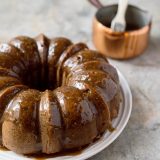Done right, sticky toffee pudding is dense, dark and decadent. But the quintessentially English dessert too often falls prey to some of the less appealing characteristics of midcentury British cookery: bland, starchy and overly sweet.
We wanted to modernize what we knew could be a delicious pudding—really a cake—by steering well clear of cloying. We got there with a few tweaks and a transatlantic twist.
Though steamed puddings have a long history, sticky toffee pudding is a relatively modern invention. It emerged in the 1970s, though there’s some debate over its exact provenance. Various shops and hotels in England’s Lake District claim to have created it.
As we developed our own version, our priority was balance. We started with the batter itself. Blending rye flour with all-purpose added a nutty flavor to the cake, taming the sweetness. And because rye flour has less gluten than wheat flours, it ensured that the cake remained relatively light and tender.
Dates are standard in sticky toffee pudding, lending sweet richness and more moisture. Classic recipes often call for soaking them in water with baking soda, which softens them. We did away with that, finding that a hot coffee soak was sufficient. Meanwhile, the bitterness of the coffee also helped balance the pudding’s sweetness.
Many recipes call for steaming the cake, a technique familiar to few American cooks. We chose to bake the pudding in a Bundt pan instead. Covering the pan with foil trapped steam rising from the baking batter and kept the cake moist enough to stay true to its steamed texture.
With our cake set, we turned our attention to the sauce. We love to repeat flavors throughout a dish to add complexity and depth. Here, we built on the flavors of the rye flour by adding a shot of rye whiskey to the sauce. Its spiciness mirrored the flavor of the cake and cut through the corn syrup and brown sugar. Orange zest brightened the caramel-like sauce.




